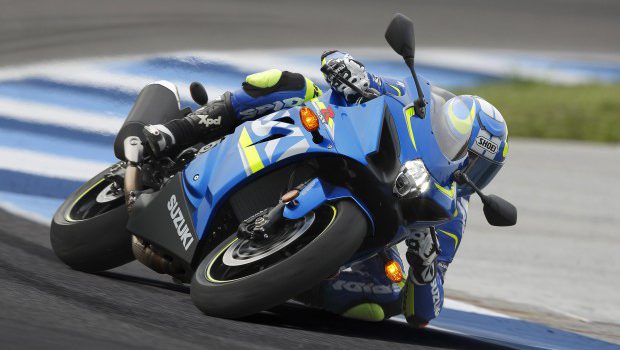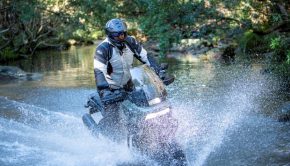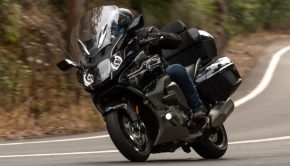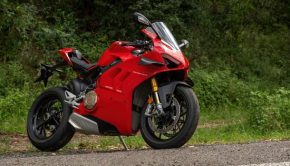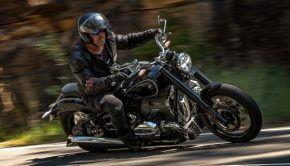2017 SUZUKI GSX-R1000R REVIEW – THE RETURN OF THE KING
Why do manufacturers build 1000cc superbikes? Especially in today’s climate of nannying, mewling and frowning. I mean, what’s the point? It’s not like anyone can actually ride these things “to their limit” (whatever that means).
The answer is quite simple. And beautiful. And encompasses everything I hold dear about motorcycling.
Manufacturers build 1000cc missiles because they can and because they must.
It’s like a genetic imperative.
Never mind the sales of sportsbikes have dropped significantly in the last five years. The big four are selling about half the missile units they once sold.
But it doesn’t matter.
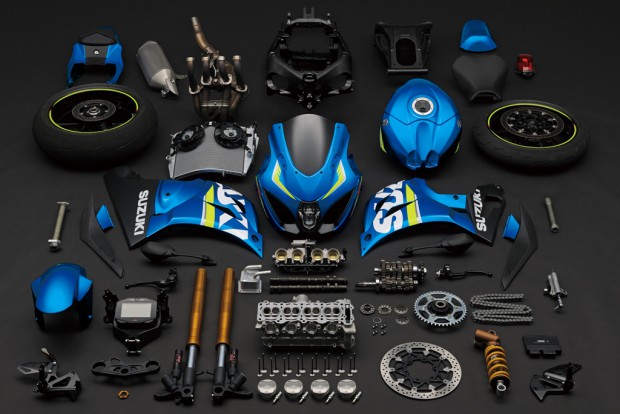
Don’t worry. Yours will come fully assembled.
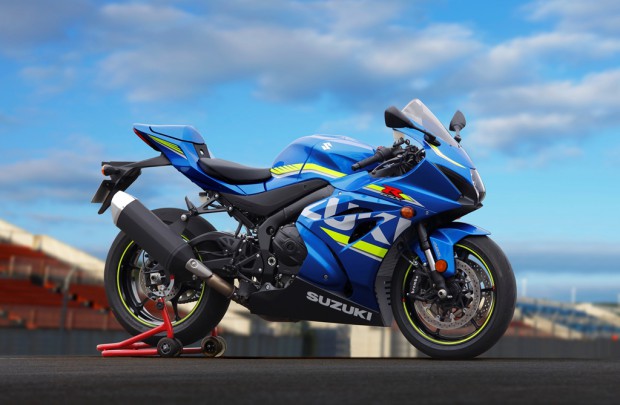
This is the GSX-R1000. The garden-variety.
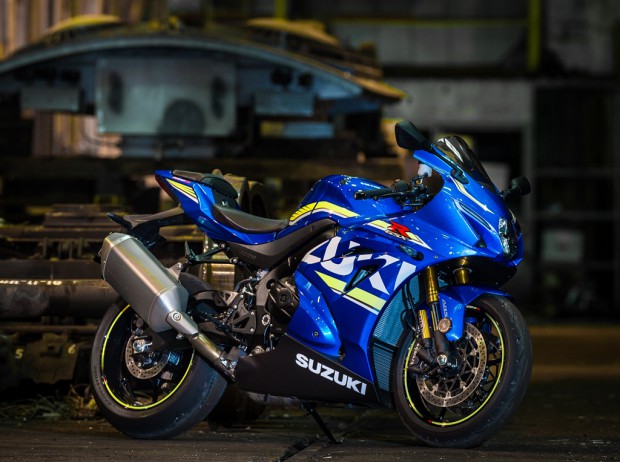
And this is the GSX-R1000R.
As Paul Vandenberg, Suzuki Australia’s General Manager stated at the world launch of the 2017 GSX-R1000 and GSX-R1000R, “It’s not about sales. We built this bike from our determination to return to the top.”
It is the greatest and most glorious pissing contest in the world.
In the last 15 years Suzuki’s GSX-R has won 41 national racing titles. It has won the World Endurance Championship 12 times and the AMA Superbike title 10 times in those 15 years.
It’s racing heritage and pedigree is solid gold.
And this naturally translated to sales on the street. The Gixxer was always trading places at the top of the heap with Honda and Yamaha, who also created class-leading litre-bikes, but Suzuki was King of the Hill more often than not.

I kinda look fast, but I’m not.
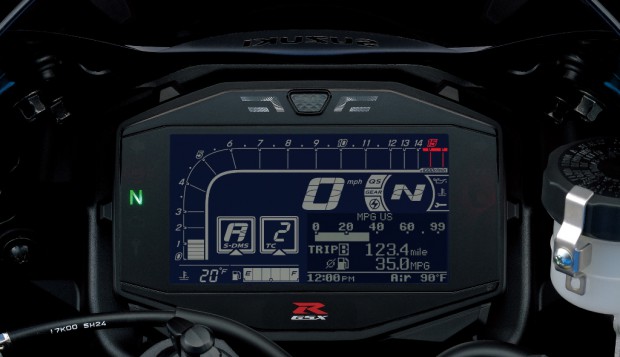
There is a lot to read. You can’t read it at 280km/h.
The Gixxer has, over the years, built quite a cult following for itself, and no greater validation for it can be given than the fact that BMW took a GSX-R, deconstructed it, re-engineered it, and created its own all-conquering superbike, the S1000RR. The Germans did not use an R1 or a Fireblade. They picked the GSX-R as the template. Imitation certainly being the most sincere form of flattery.
But then things got weird. Following the introduction of the S1000RR in 2009 (just after the Global Financial Crisis of 2007-2008), it was some years before anyone would stir to address the German trump-card.
It was 2015 before Yamaha bestirred itself and built the brilliant R1, and suddenly there were two players back on the scene.
“But what about Suzuki?” the fans cried. “Where’s our bloody Gixxer?!”
Suzuki did of course produce ‘new’ models in that time. But they were small tweaks, mainly to do with styling – one even came with red lipstick smeared on its fairing – and it looked like nothing was being done about Suzuki reclaiming its throne.

Oh…God…is that Turn One?
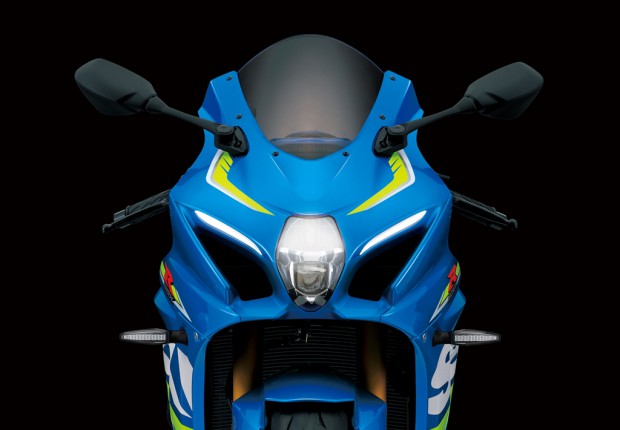
Slimmer and sexier. Not like me.
But of course, something was being done.
Something is always being done.
And you only had to look at the factory’s return to MotoGP to understand that.
The Gixxer faithful longed and pined for a true world-beating GSX-R to emerge from Hamamatsu, and in 2017, it has.
The 2017 GSX-R, in both its iterations, is all new. It is the most powerful and most technologically advanced GSX-R ever built.
And of course it must be.
If Suzuki was ever going to “Own The Racetrack” as it once did, then this new Gixxer had to be a serious player.
And of course it is.

Oh god…more geese…
SO WHAT, TECHNICALLY SPEAKING, HAS HAPPENED TO THE GIXXER?
Lots. Everything, actually. Including bona fide MotoGP technology.
Here are the numbers…
The old Gixxer made 136.4kW at 11,500rpm.
The 2017 Gixxer makes 148.5kW at 13,200rpm.
The old Gixxer had 116.7Nm at 10,000rpm
The 2017 Gixxer makes 117.6Nm at 10,800rpm
The old Gixxer red-lined at 13,500.
The 2017 Gixxer redlines at 14,500.
But that’s just the numbers. There’s more.
The old Gixxer had SDTV throttle bodies and bucket tappets.
The 2017 Gixxer has electronic throttle bodies and MotoGP-like finger followers to finger-bang the valve train like a mad teenager.
The old one had a balancer shaft.
The new one has no balancer shaft.
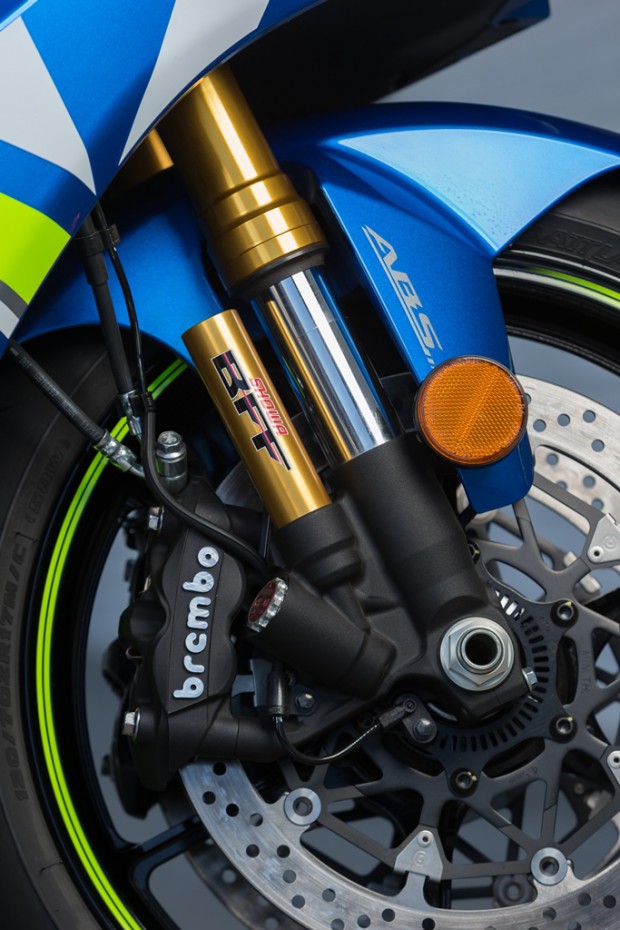
Best Friends Forever forks.
The old steel exhaust valves are now titanium, the piston diameter has increased from 74.5mm to 76mm, and there’s this trick Variable Valve Timing thing Suzuki has been using in its MotoGP bikes. It works on centrifugal force and utilises ball-bearings that are flung outwards as the plate spins, and this makes them angry, and they therefore provide more power up top. You can almost feel it happening at about 10,000rpm. It’s subtle, but it’s there. Or maybe that was just my kidneys failing.
It breathes better at higher rpm via the stacked funnels and the SRAD is more efficient.
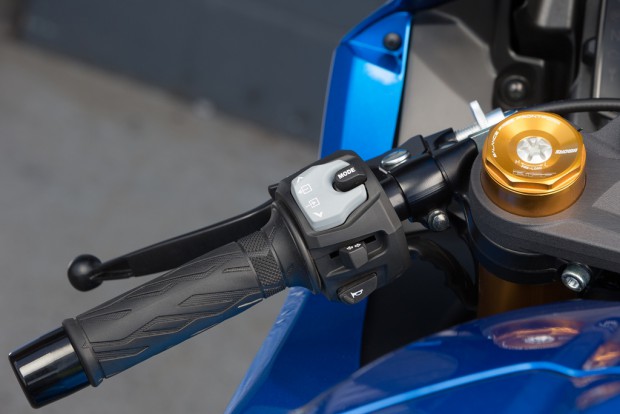
You keep mashing this button until you’re happy.
The whole engine is 22mm shorter and 6.6mm narrower, and the bike’s geometry has been changed – it’s 20mm shorter from the front axle to the swing-arm pivot, and 40mm longer from there to the rear axle.
The whole frame is brand new, and the bike is narrower and more aerodynamic.
Even the exhaust system is new and trick – and dubbed the Suzuki Exhaust Tuning-Alpha (SET-A). Basically, servo-operated exhaust valves live inside the exhaust balancer tubes. They are closed in low- and mid-range and open when you’ve really got to show the Highway Patrol who’s boss.

Oh God…someone else is going to overtake me.
And if you’re still being crazy and insane about the size of the can, you need to kill yourself, OK? Not one of those cans will survive longer than the time it takes a new owner to fit a Yoshi muffler to the exhaust system. There’s lots of titanium inside the stock can, so you can take it home, cut it apart and make nice jewellery for your missus, so there’s that.
But over and above all the rubbing and bouncing and finger-banging, there is an amazing suite of electronics making it all work that is simply outstanding.
Suzuki really focused hard on this and it’s evident.
The brain is a 32-bit dual processor ECU. It does wizard shit. And it does it via an Inertial Measurment Unit that does sorcery in three axes and six different directions. The ECU also chats constantly with the throttle bodies, the ignition timing control, the front wheel, the back wheel, the crank, the gear-shifter, the throttle position and the throttle-grip position. It knows what you want better than you know what you want.
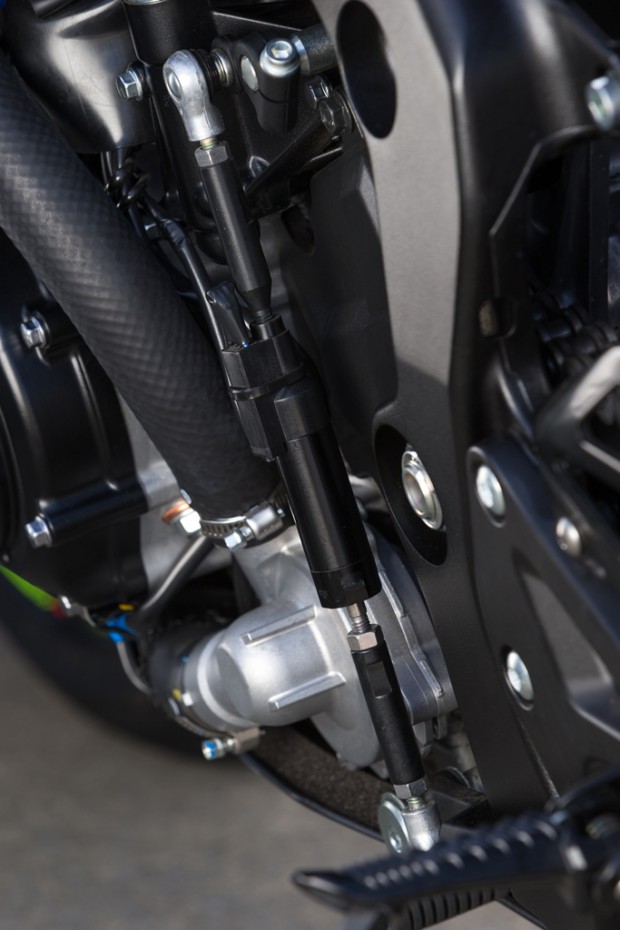
The best quick-shifter in the business.
Then there’s three drive modes – A, B and C. Which is basically unleash more than all the Hell, unleash all the Hell, and unleash all the Hell but remember it’s wet or the rider is uncertain and should have bought a LAMs bike.
There is also ten-level traction control, launch control (perfect for unleashing Hell on Lygon Street every Friday night), an easy start system (press the starter button once and let it go. No need to keep your finger there), and Low RPM Assist. I can only presume this is for champions who struggle to ride the bike at low speed. Essentially, the ECU reads your throttle inputs, realises you’re an arse-clown who is going to stall the bike, activates the air-bleed system, raises the rpm a touch and makes you look like a pro at low speeds.
Which brings me to the shift-assist. It is the best in the business, both changing up and changing down. Smooth and precise, every time. I even put it into first gear coming into Honda (yes, it was a mistake) and nothing bad happened at all thanks the Suzuki Clutch Assist System thing. No lock-up. Just so the wrong gear for the corner exit, which was on me.

See all the heat coming out of the exhaust? I couldn’t.
I DON’T UNDERSTAND ANY OF THIS
That’s alright. I don’t either. But I do understand what it means when you twist that throttle. The 2017 Gixxer is so much easier to ride quick than all the previous models. It delivers linear power all the way to redline and its low- and mid-range is staggeringly potent. But not in a way that makes you feel like it’s going to pull your arms out and leave you face down on the bitumen in front of a skidding police car.
It’s not “gentle”, by any means. It’s…well, yes, potent.
Some of the racers on the launch were making racer noises about how the bike felt a little “lazy” getting to its top speed. I’m no racer, but nothing on the Gixxer felt lazy or feathery or hesitant or unwilling to me. It felt nothing but refined and potent – yes, there’s that word again. I keep using it because no other word describes how the entire package feels.
I would jam that throttle wide open coming out of Turn 12 at Phillip Island and the face of Jesus appeared smiling at me from the first overbridge. I saw 264 on the speedo before I ran out of prayers. Yes, there was more there. Of course there was. But that was all I needed to see. Getting there was not a goggle-eyed terror-fest. It just got there with intent, rather than malice. This is no small thing. Civilising such weapons so that normal people can ride them, and ride them fast, is an engineering super-feat, and one Suzuki is justifiably proud of.
In terms of handling and outer limits being explored, well there was none of that. The back-end squirmed out on me once coming out of Southern Loop after I had melted the tyres a bit, but the ECU bitch-slapped everything back into line before I had even realised it was happening. I had all the traction thingies set in the middle, and this was my happy place. Yes, you can turn it off and change it on the fly, just chop the throttle off and start pressing.

Missed the geese again. Happy days.
The Gixxer turned predictably and easily, and fed me more information than I could ever use from the killer front-end. The GSX-R1000R (we did not ride the single R version) has Balance Free Front forks (with that hell sexy golden reservoir thingo just like on the grown-up race bikes) and a Balance Free rear shock. No, I had no idea what that meant either so I looked it up on the Showa website. It’s basically all about making the damping respond better.
This is what Showa says:
“This product incorporates a hydraulic circuit that makes it difficult to generate variation in the pressure balance, one of the weaknesses of existing dampers. Having the compression and tension sides of the damping force generators integrated outside the cylinder, it paved the way for smooth and optimal oil flow and achieved outstanding levels of traction and absorbency based on the enhanced damping force response. Pressurization for control at the initial stage of movement attained riding comfort at low speeds and stability at high speeds, two contrasting characteristics at the highest level ever.”
For me, this meant the bike felt wonderfully balanced and smooth, but I was on a newly-resurfaced racetrack. It would be nice to get it out onto the road and see how our goat-tracks slap it around.
The tank is 21mm lower, so even though I’ve maybe gone up a dress size, I can still push my aching body into a race crouch of sorts. The ride position is racier and more aggressive than previous models, but it’s still pretty good if all you do is the odd track-day and spend most of your time on the road. It didn’t feel as cramped and brutal as the S1000RR and the R1.
The dash was pretty busy, and it would take a little time getting used to it, I reckon. I didn’t spend a lot of time looking at anything but the big speed number and changing gears when the flashing change light said I should. The R version has a very sexy black background on its dash and the cooking model has the normal khaki-coloured background.
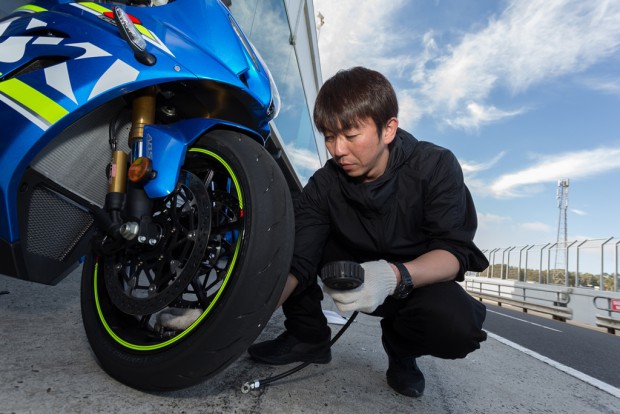
“See how sassy that big bloke is when I put 120psi into the front…”
SO THIS RACETRACK BUSINESS. WHAT HAPPENED AT PHILLIP ISLAND, FATSO?
Well, I didn’t die. That was the first thing.
The second thing is that I cannot really describe what an absolute joy and privilege it is to be on the same racetrack as Cam Donald, Steve Martin, Chris Vermuelen, Kevin Magee, Shawn Giles, Sloane Frost, Mark Willis and Josh Waters. Being passed by these race-beasts is something that stays with you forever. Seeing Sloane Frost hammering out of Turn Three on the outside of me at twice the speed I was going, hunched over and feral with velocity and purpose, is just brilliant. Watching these blokes (even if only for a corner or two) doing their thing is fabulous. And I’m sure you’re keen to read what they thought of the bike in case you ever upskill yourself to their level and it becomes relevant.
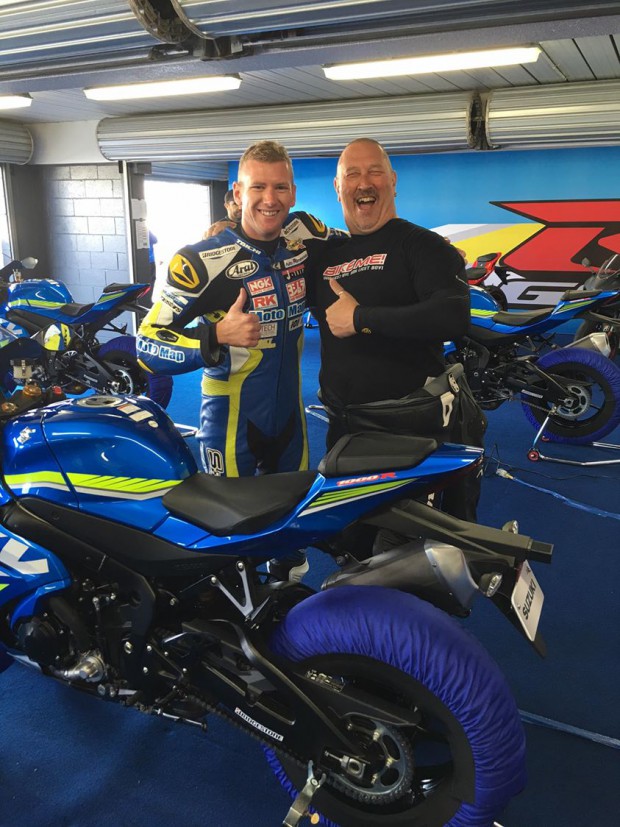
Young Mr Waters. He needs to eat more baclava.
I can only tell you what it’s like to ride for a normal bloke.
My day went like this…
After the pre-ride briefing where I was informed that a yellow flag would be displayed if hit a Cape Barren goose, I went downstairs into the pit garage where Bike Number 11 had been allotted to me.
It sat there in its tyre warmers baking its excellent new Bridgestone RS10s. While the tyres baked, I had a nice Suzuki seat to sit on, a tech to chat to, and a Japanese development guy to consult. I felt very much like two professional racers rolled into one, because that’s how big I am.
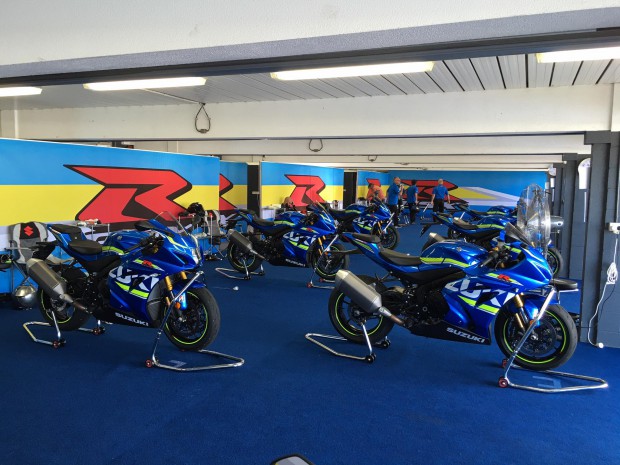
Mine is the one in the middle.
We were sent out in two groups, so there were never more than seven bikes on the track. The lead rider, either Josh Waters, Hikaru Oshiro (Suzuki test rider) or Jurgen Plaschka (the other Suzuki test rider) would lead us out for two warm-up laps, then pull over to the side just as we came onto the main straight and leave us to our own devices.
Now when I say “warm-up” laps, I’m sure you’re thinking the same thing I was thinking, ie. “We’re just going to take it easy here. Get the blood flowing and the tyres paying attention.”
Except you’d be wrong. Warm-up laps for top-level racers on high-powered superbikes are fast enough for the brown poo-turtle to start nuzzling my underpants.
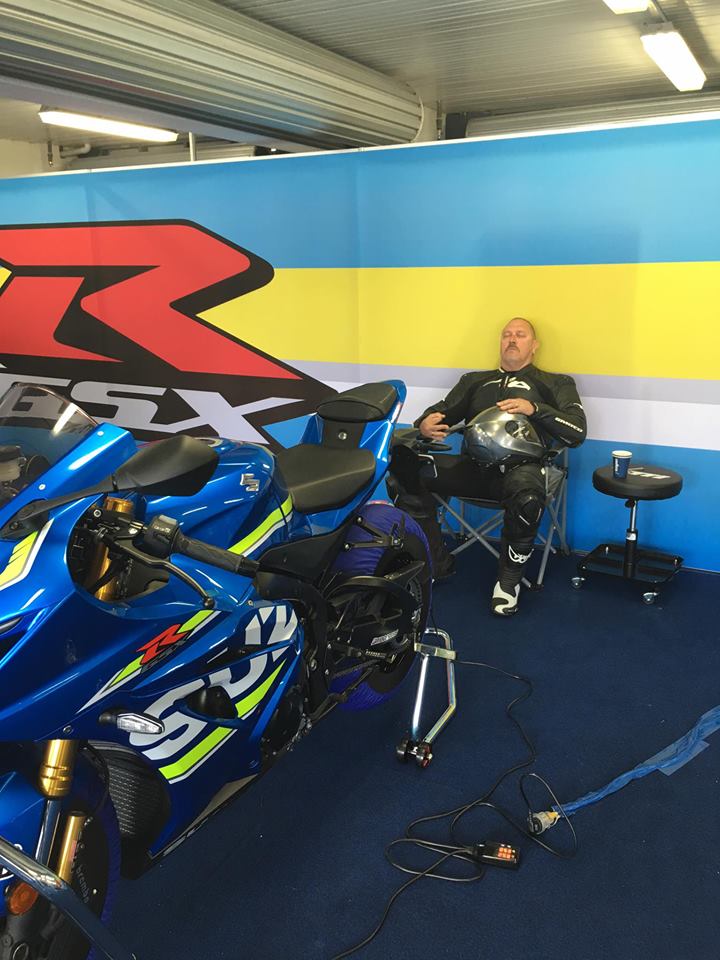
Some quiet time between laps to centre myself.
They’re fucking kidding, I thought, arcing into Southern Loop and watching them getting the power down and simply pissing off into the distance.
I applied myself. And kept up for the warm-up laps. Of course, the second the lead-rider put his blinker on and pulled over, the pack just opened the taps and went.
Lord, oh Lord how it went.
I banged on as hard as I could and tried to make sense of the new Gixxer. It was certainly ferocious, but predictably so, if that makes sense. It felt hugely competent, because it is, but it was important it felt that way to blokes who aren’t riding at Vermuelen’s level.
I did eight laps and came in.
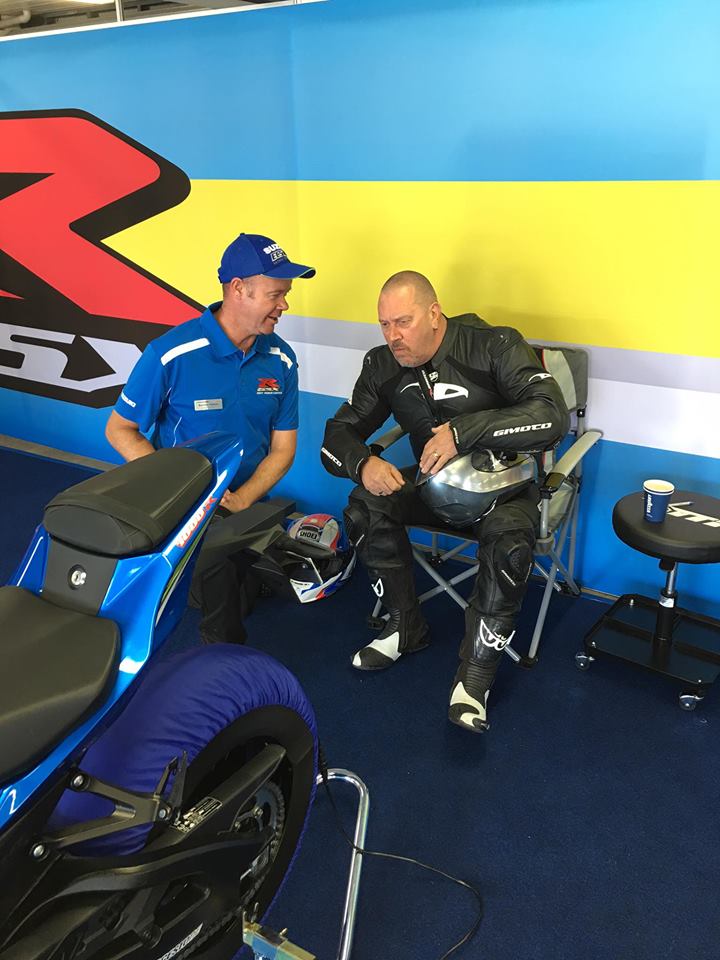
“You’re not going to go any faster, are you?”
Immediately the full racer experience kicked in. The tech held my bike while I dismounted and I was surrounded by a cluster of Japanese engineers who wanted to know what needed tweaking, changing or adjusting.
I was in A mode, with the traction control setting around three. Everything seemed just fine. I couldn’t imagine it being any finer.
“Seems fine to me,” I grinned.
“No adjustment?”
“I’m like Casey Stoner, mate,” I shrugged. “I ride around the problems.”
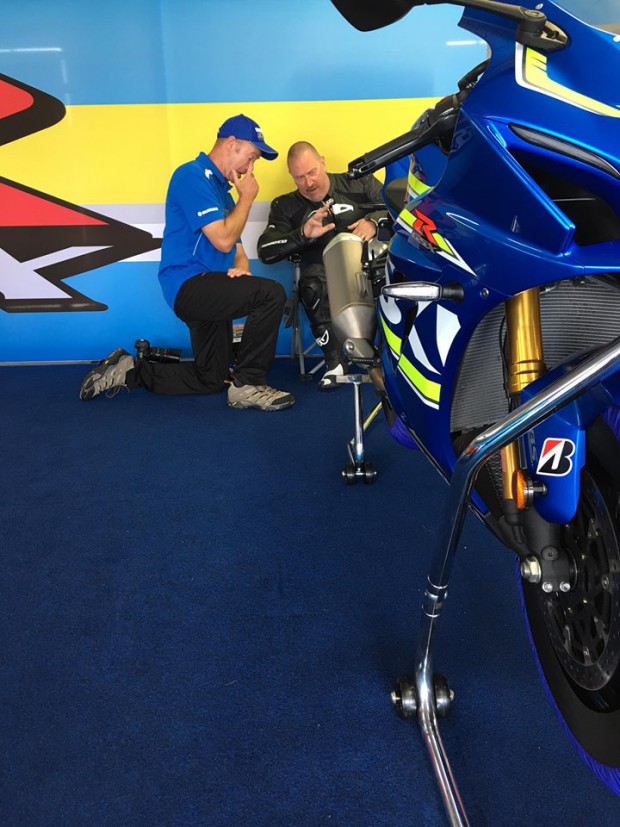
“No. I’m not. Stop asking.”
I’m not sure if the Japanese understood me, but they went off to discuss my inputs.
I did two more sessions, and my personal tech told me that after lunch, he was going to switch off the Traction Control and put on the super-sticky full-race Bridgestones.
“Do not touch the traction control,” I said to him.
He grinned. “Oh go on.”
“If we’re gonna stay friends, you will not turn off the traction control. Cool?”
“Cool,” he said. “You want me to change any settings?”
“Nope.”
“Easy day for me then.”
“That’s the plan,” I said, and went to sit in my Suzuki seat.
You can’t actually turn the ABS off on road-going bikes. But it was nice of Suzuki to offer up that option on the track. I’m not like the blokes with sponsorship on their leathers. I need to spend lots of time with a bike before I start screwing with it. And it’s not like the Gixxer was doing anything wrong on the settings it was on. Well enough should be left well enough alone.
Around me I could hear the racers discussing their times.
This stock Gixxer, on stock tyres, was lapping in the high 30s.
After lunch, when the sticker R10 Bridgie track tyres went on, these times dropped into the mid-30s. There was talk of a Japanese rider blasting out a 1:34 a few days ago.
Suzuki was timing people, me included, and I was told that I had managed to lap in just under two minutes. Had I won a round of the WSBK I couldn’t have been happier. A 1:59.9999 was just fine. Even if it was a one-off and all my other laps were three-minute extravaganzas.
The point here is that even a plodding clodkin like me could belt this thing around the track at a respectable pace. Never mind how quick the quick blokes could do it.
For me to able to do that meant the bike had to be eminently rideable at pace. It meant it had to be quick enough to get it on, but not brutal enough to terrify me.
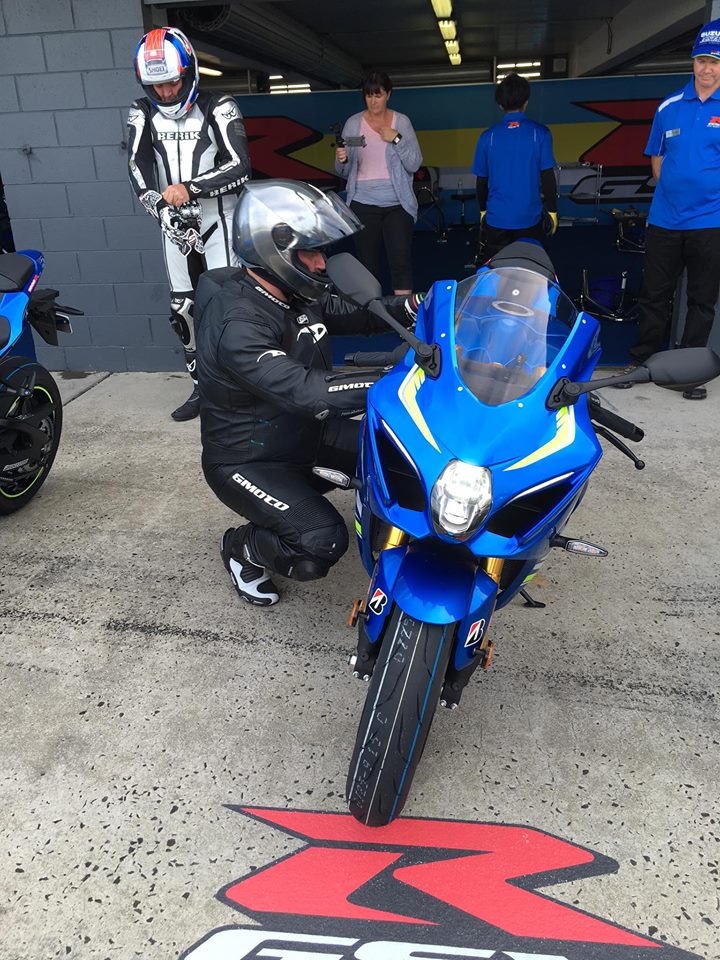
Took me about five minutes to get out of the squat position.
CONCLUSION
The Gixxer has the best gearbox in the world. Coupled with the best shift-assist yet built, it’s a joy to ride at pace, even if you’re not a racer – well, especially if you’re not a racer.
The engine is a powerhouse, responsive and keen, but not in a hard-edged feral kind of way, so it’s a real pleasure to get into it on the track. I can imagine it would be a hatful of hoots on the road as well.
The Gixxer has been engineered to perfection, from its superb and pliable suspension to its new Brembos (with bigger actual Brembo rotors on the front), and that amazing computer that helps you do everything every time all the time.
Tyres turning into sludge on a trackday? No dramas. The ECU has your back. Overcooked a corner? Sorted. Wanna race-launch your manhood off the lights? Press this button, dump the clutch, then come back and collect the panties.
Suzuki understood perfectly well what was at stake launching the new GSX-R.
There were expectations. High ones. The faithful have waited a long time, so it had better be right.
Suzuki knew that. It really tried with this bike.
And succeeded completely and comprehensively.
The King has returned. Welcome back, Your Majesty.
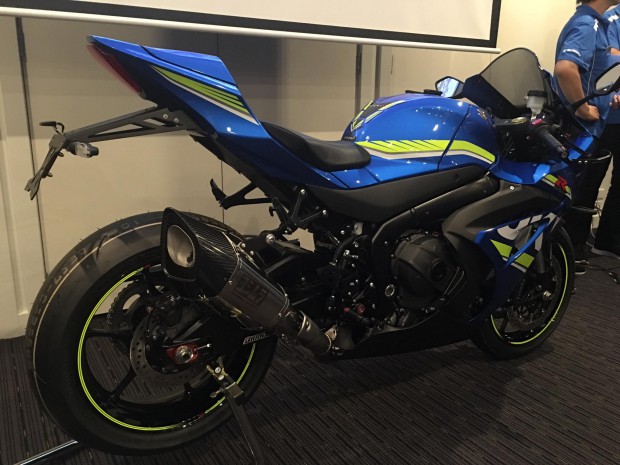
This is what it looks like with a Yoshi can.
HOW MUCH
The standard GSX-R1000 is tipped to be under 23K.
The up-spec GSX-R1000R will come in under 26K.
WHAT COLOURS CAN I HAVE?
The GSX-R1000 comes in red, matte black and the factory blue.
The GSX-R1000R comes in glossy black and factory blue.
WHAT’S THE DIFFERENCE?
The GSX-R1000R comes with the balance free suspension, up-down quick-shifter, the sexy dash, launch control, a lightweight battery, and daytime LED running lights on the fairing. Yeah, it’s worth the extra bucks, I think. That black dash is sexy as.
YES, THERE’S A SPECIAL VIDEO COMING. PLEASE BE PATIENT.
SPECS
Max Power – 148.6kW(202hp)@13,200rpm
Max Torque – 117.6Nm@10,800rpm
Engine – Liquid-cooled, in-line four-cylinder, DOHC, 13.2:1 compression, 76 x 55.1mm bore x stroke, 999.8cc, Suzuki Racing Variable Valve Timing, RbW
Transmission – Six-speed, constant mesh
Clutch – Suzuki Clutch Assist System
Fuel Capacity – 16L
Front suspension – Showa Balance Free Forks
Rear suspension – Balance Free Lite rear shock
Front brake – Brembo radial monobloc four-piston calipers, 320mm rotors, Motion Track Brake System
Rear brake – Single-piston caliper, 220mm rear rotor, Motion Track Brake System
Wheels – Six-spoke cast aluminium wheels
Tyres – 120/70 ZR17 M/C, 190/55 ZR17 M/C
Seat height – 825mm
Wheelbase – 1420mm
Length – 2075mm
Width – 705mm
Height – 1145mm
Rake – 23.2°
Trail – 95mm
Wet weight – 203kg
GEAR
My helmet was a Nolan. Yoy may read my review HERE.
My brilliant Gimoto suit and gloves were supplied by OZMC Leathers. You may find them HERE.

